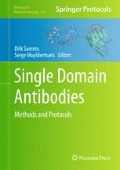Abstract
The successful application of antibody fragments such as VHHs in diagnostic assays, affinity purification, imaging, or therapy is not determined by the specificity and affinity of the antibody fragment alone. The ability to bind the target protein in the environment in which the antibody fragment is intended to functionally perform determines to a great extent its success. To identify antibodies with the required stability profile selection of naturally occurring variants from an immune library or mutants from an engineered library should be performed via phage display. The conditions under which the designed antibodies displayed on phage bind to the target ideally should mimic the environment in which the antibody should be effective. After selection individual antibodies need to be tested in appropriate screening assays, again taking into account the conditions under which the antibody should bind to the target and induce the desired effect.
Access this chapter
Tax calculation will be finalised at checkout
Purchases are for personal use only
References
van der Linden RH, Frenken LG, de Geus B, Harmsen MM, Ruuls RC, Stok W, de Ron L, Wilson S, Davis P, Verrips CT (1999) Comparison of physical chemical properties of llama VHH antibody fragments and mouse monoclonal antibodies. Biochim Biophys Acta 1431:37–46
Pérez JM, Renisio JG, Prompers JJ, van Platerink CJ, Cambillau C, Darbon H, Frenken LG (2001) Thermal unfolding of a llama antibody fragment: a two-state reversible process. Biochemistry 40:74–83
Dolk E, van Vliet C, Perez JM, Vriend G, Darbon H, Ferrat G, Cambillau C, Frenken LG, Verrips T (2005) Induced refolding of a temperature denatured llama heavy-chain antibody fragment by its antigen. Proteins 59:555–564
Dolk E, van der Vaart M, Lutje Hulsik D, Vriend G, de Haard H, Spinelli S, Cambillau C, Frenken L, Verrips T (2005) Isolation of llama antibody fragments for prevention of dandruff by phage display in shampoo. Appl Environ Microbiol 71:442–450
Dumoulin M, Conrath K, Van Meirhaeghe A, Meersman F, Heremans K, Frenken LG, Muyldermans S, Wyns L, Matagne A (2002) Single-domain antibody fragments with high conformational stability. Protein Sci 11:500–515
Jung S, Honegger A, Plückthun A (1999) Selection for improved protein stability by phage display. J Mol Biol 294:163–180
Jespers L, Schon O, Famm K, Winter G (2004) Aggregation-resistant domain antibodies selected on phage by heat denaturation. Nat Biotechnol 22:1161–1165
Olichon A, Schweizer D, Muyldermans S, de Marco A (2007) Heating as a rapid purification method for recovering correctly-folded thermotolerant VH and VHH domains. BMC Biotechnol 26:7
van der Vaart JM, Pant N, Wolvers D, Bezemer S, Hermans PW, Bellamy K, Sarker SA, van der Logt CP, Svensson L, Verrips CT, Hammarstrom L, van Klinken BJ (2006) Reduction in morbidity of rotavirus induced diarrhoea in mice by yeast produced monovalent llama-derived antibody fragments. Vaccine 24:4130–4137
Bezemer S, van de Burg M, de Haard HJ, Tareilus E (2001) Antibody heavy chain variable domains against human dietary lipases, and their uses. Patent Application, EP1134231
Klooster R, Maassen BT, Stam JC, Hermans PW, Ten Haaft MR, Detmers FJ, de Haard HJ, Post JA, Verrips TC (2007) Improved anti-IgG and HSA affinity ligands: clinical application of VHH antibody technology. J Immunol Methods 324:1–12
Verheesen P, ten Haaft MR, Lindner N, Verrips CT, de Haard JJ (2003) Beneficial properties of single-domain antibody fragments for application in immunoaffinity purification and immuno-perfusion chromatography. Biochim Biophys Acta 1624:21–28
Acknowledgements
This work has mainly been performed at Unilever Research Vlaardingen.
Author information
Authors and Affiliations
Corresponding author
Editor information
Editors and Affiliations
Rights and permissions
Copyright information
© 2012 Springer Science+Business Media, LLC
About this protocol
Cite this protocol
Dolk, E., Verrips, T., de Haard, H. (2012). Selection of VHHs Under Application Conditions. In: Saerens, D., Muyldermans, S. (eds) Single Domain Antibodies. Methods in Molecular Biology, vol 911. Humana Press, Totowa, NJ. https://doi.org/10.1007/978-1-61779-968-6_13
Download citation
DOI: https://doi.org/10.1007/978-1-61779-968-6_13
Published:
Publisher Name: Humana Press, Totowa, NJ
Print ISBN: 978-1-61779-967-9
Online ISBN: 978-1-61779-968-6
eBook Packages: Springer Protocols

